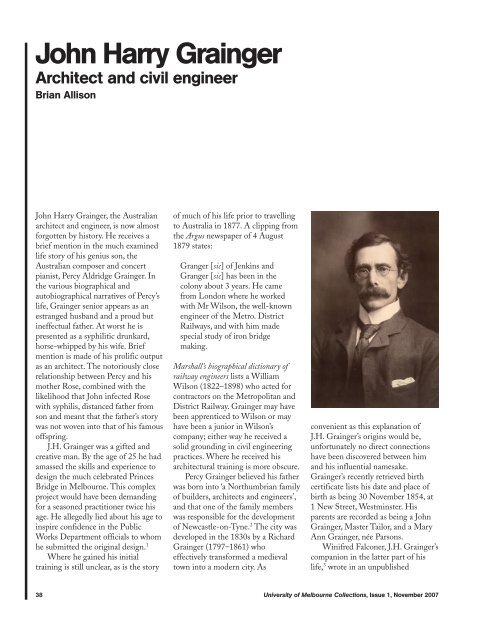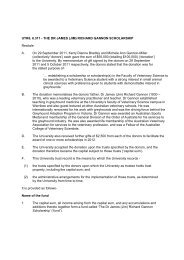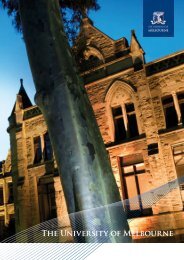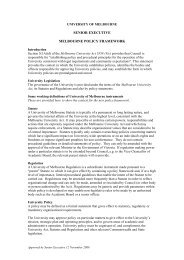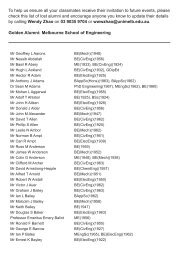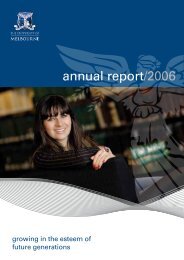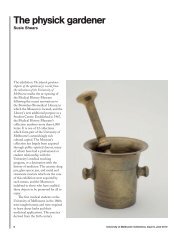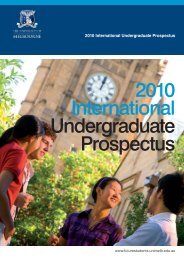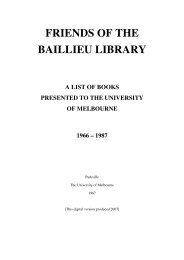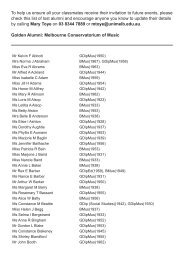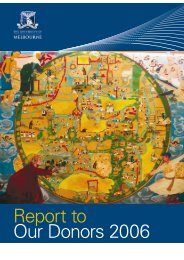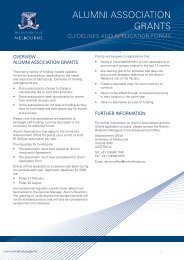John Harry Grainger - University of Melbourne
John Harry Grainger - University of Melbourne
John Harry Grainger - University of Melbourne
You also want an ePaper? Increase the reach of your titles
YUMPU automatically turns print PDFs into web optimized ePapers that Google loves.
<strong>John</strong> <strong>Harry</strong> <strong>Grainger</strong><br />
Architect and civil engineer<br />
Brian Allison<br />
<strong>John</strong> <strong>Harry</strong> <strong>Grainger</strong>, the Australian<br />
architect and engineer, is now almost<br />
forgotten by history. He receives a<br />
brief mention in the much examined<br />
life story <strong>of</strong> his genius son, the<br />
Australian composer and concert<br />
pianist, Percy Aldridge <strong>Grainger</strong>. In<br />
the various biographical and<br />
autobiographical narratives <strong>of</strong> Percy’s<br />
life, <strong>Grainger</strong> senior appears as an<br />
estranged husband and a proud but<br />
ineffectual father. At worst he is<br />
presented as a syphilitic drunkard,<br />
horse-whipped by his wife. Brief<br />
mention is made <strong>of</strong> his prolific output<br />
as an architect. The notoriously close<br />
relationship between Percy and his<br />
mother Rose, combined with the<br />
likelihood that <strong>John</strong> infected Rose<br />
with syphilis, distanced father from<br />
son and meant that the father’s story<br />
was not woven into that <strong>of</strong> his famous<br />
<strong>of</strong>fspring.<br />
J.H. <strong>Grainger</strong> was a gifted and<br />
creative man. By the age <strong>of</strong> 25 he had<br />
amassed the skills and experience to<br />
design the much celebrated Princes<br />
Bridge in <strong>Melbourne</strong>. This complex<br />
project would have been demanding<br />
for a seasoned practitioner twice his<br />
age. He allegedly lied about his age to<br />
inspire confidence in the Public<br />
Works Department <strong>of</strong>ficials to whom<br />
he submitted the original design. 1<br />
Where he gained his initial<br />
training is still unclear, as is the story<br />
<strong>of</strong> much <strong>of</strong> his life prior to travelling<br />
to Australia in 1877. A clipping from<br />
the Argus newspaper <strong>of</strong> 4 August<br />
1879 states:<br />
Granger [sic] <strong>of</strong> Jenkins and<br />
Granger [sic] has been in the<br />
colony about 3 years. He came<br />
from London where he worked<br />
with Mr Wilson, the well-known<br />
engineer <strong>of</strong> the Metro. District<br />
Railways, and with him made<br />
special study <strong>of</strong> iron bridge<br />
making.<br />
Marshall’s biographical dictionary <strong>of</strong><br />
railway engineers lists a William<br />
Wilson (1822–1898) who acted for<br />
contractors on the Metropolitan and<br />
District Railway. <strong>Grainger</strong> may have<br />
been apprenticed to Wilson or may<br />
have been a junior in Wilson’s<br />
company; either way he received a<br />
solid grounding in civil engineering<br />
practices. Where he received his<br />
architectural training is more obscure.<br />
Percy <strong>Grainger</strong> believed his father<br />
was born into ‘a Northumbrian family<br />
<strong>of</strong> builders, architects and engineers’,<br />
and that one <strong>of</strong> the family members<br />
was responsible for the development<br />
<strong>of</strong> Newcastle-on-Tyne. 2 The city was<br />
developed in the 1830s by a Richard<br />
<strong>Grainger</strong> (1797–1861) who<br />
effectively transformed a medieval<br />
town into a modern city. As<br />
convenient as this explanation <strong>of</strong><br />
J.H. <strong>Grainger</strong>’s origins would be,<br />
unfortunately no direct connections<br />
have been discovered between him<br />
and his influential namesake.<br />
<strong>Grainger</strong>’s recently retrieved birth<br />
certificate lists his date and place <strong>of</strong><br />
birth as being 30 November 1854, at<br />
1 New Street, Westminster. His<br />
parents are recorded as being a <strong>John</strong><br />
<strong>Grainger</strong>, Master Tailor, and a Mary<br />
Ann <strong>Grainger</strong>, née Parsons.<br />
Winifred Falconer, J.H. <strong>Grainger</strong>’s<br />
companion in the latter part <strong>of</strong> his<br />
life, 3 wrote in an unpublished<br />
38<br />
<strong>University</strong> <strong>of</strong> <strong>Melbourne</strong> Collections, Issue 1, November 2007
Opposite: Bartletto Studio, <strong>John</strong> <strong>Grainger</strong> aged<br />
46, photographed in Perth, Western Australia,<br />
c.1890, silver gelatin print, 20.5 x 14.0 cm.<br />
<strong>Grainger</strong> Museum Collection,<br />
<strong>University</strong> <strong>of</strong> <strong>Melbourne</strong>.<br />
Below: H.W. De Mole, Princes Bridge over the<br />
Yarra River, c.1888, heliotype, 33.0 x 42.5 cm.<br />
<strong>Grainger</strong> Museum Collection,<br />
<strong>University</strong> <strong>of</strong> <strong>Melbourne</strong>.<br />
manuscript in the 1930s that<br />
<strong>Grainger</strong> had lived with an uncle who<br />
was an important influence on him<br />
during his childhood. The gentleman<br />
was a personal friend <strong>of</strong> the great<br />
theologian Cardinal Newman and the<br />
young <strong>Grainger</strong> ‘derived great<br />
pleasure as well as knowledge from<br />
listening to their discussions <strong>of</strong> the<br />
world’s affairs’. 4 His uncle was also<br />
interested in music and took <strong>Grainger</strong><br />
to his personal box at the opera.<br />
Reference to the uncle also appears in<br />
the unpublished recollections <strong>of</strong><br />
<strong>Grainger</strong> by another close friend,<br />
South Australian musician Herman<br />
Schrader. He states that the uncle<br />
took <strong>Grainger</strong> to the Monday Pops<br />
Concerts at the Queens Hall. 5<br />
It is not known why <strong>Grainger</strong> was<br />
brought up in his uncle’s home. His<br />
parents were not deceased—they are<br />
listed as still living in Westminster in<br />
the 1881 census. Percy believed that<br />
his father received much <strong>of</strong> his<br />
education at a monastery school in<br />
France at Yvetot (between Le Havre<br />
and Paris). This detail is confirmed by<br />
Winifred Falconer. 6 <strong>John</strong> Bird, Percy<br />
<strong>Grainger</strong>’s biographer, states that<br />
J.H. <strong>Grainger</strong> claimed to have been in<br />
Paris during the siege near the end <strong>of</strong><br />
the Franco-Prussian War (in 1870–<br />
1871). 7 This begs the question: what<br />
was the son <strong>of</strong> a Westminster tailor<br />
doing at school in France? One<br />
possible explanation is that <strong>Grainger</strong>’s<br />
uncle—his guardian—may have had<br />
business interests on the continent.<br />
The experience <strong>of</strong> French culture<br />
in his formative years left <strong>Grainger</strong><br />
with a lifetime love <strong>of</strong> French<br />
architecture. At some juncture, early<br />
in his career, he made a very detailed<br />
study <strong>of</strong> French revival styles—<br />
<strong>University</strong> <strong>of</strong> <strong>Melbourne</strong> Collections, Issue 1, November 2007 39
particularly Renaissance revival<br />
architecture—a style in which he<br />
proved to be very pr<strong>of</strong>icient as a<br />
designer. If, as he claimed, he was in<br />
Paris at age 16, conceivably he may<br />
have had an association with an<br />
architectural atelier where he could<br />
have received some training.<br />
At age 22 <strong>John</strong> <strong>Harry</strong> <strong>Grainger</strong><br />
successfully applied for a position in<br />
the South Australian Government as<br />
an assistant architect and engineer. It<br />
is unclear why he chose to emigrate.<br />
In his 1954 memoir ‘My father in my<br />
childhood’, Percy refers to his father<br />
leaving a girl in England who was<br />
pregnant to him. 8 Falconer says that<br />
his decision to move abroad followed<br />
a quarrel with his uncle. Whatever his<br />
motivation, his career decision proved<br />
to be well made. In addition to his<br />
government position he developed a<br />
thriving private practice in Adelaide.<br />
Less than 18 months later in 1878 he<br />
resigned his government position to<br />
pursue private commissions.<br />
<strong>Grainger</strong> developed a strong social<br />
network in South Australia. He<br />
became very active within the musical<br />
fraternity and organised the first<br />
string quartet in Adelaide. The<br />
ensemble rehearsed in his private<br />
rooms. Though not an instrumentalist<br />
<strong>Grainger</strong> was musically literate and<br />
collected a library <strong>of</strong> musical scores<br />
now held in the <strong>Grainger</strong> Museum.<br />
He is also said to have had a strong<br />
tenor singing voice. 9 Herman<br />
Schrader wrote <strong>of</strong> him that his ‘love<br />
for music was very great and<br />
absolutely cosmopolitan, embracing<br />
all styles, opera, oratorium [sic],<br />
orchestral, chamber and solo music<br />
enjoying all according to their<br />
different merits’. 10<br />
<strong>Grainger</strong>’s social circle included a<br />
Mr George Aldridge who owned the<br />
Prince Alfred Hotel next door to the<br />
government <strong>of</strong>fices where <strong>Grainger</strong><br />
worked. He became a frequent visitor<br />
to the Aldridge family home and in<br />
1880 married 22-year-old Rosa<br />
(Rose) Aldridge.<br />
In the year <strong>of</strong> their marriage<br />
<strong>Grainger</strong> won the competition to<br />
design Princes Bridge over the Yarra<br />
River in association with surveyor and<br />
architect, J.S. Jenkins, with whom he<br />
had entered into a partnership<br />
(though the design is considered to be<br />
<strong>Grainger</strong>’s). <strong>Grainger</strong> and his wife<br />
moved to <strong>Melbourne</strong> where he<br />
completed the finished drawings and<br />
hoped to oversee the construction <strong>of</strong><br />
the bridge. Actual building work did<br />
not start until 1885 and the bridge<br />
took another three years to be<br />
formally opened.<br />
In the same year that <strong>Grainger</strong><br />
won the Princes Bridge competition<br />
he designed a swinging bridge over<br />
the La Trobe River at Sale in<br />
Gippsland. The late architectural<br />
historian Margaret Pitt Morison<br />
described it as an ‘elegant trussed<br />
structure in wrought iron with a<br />
balanced wing span <strong>of</strong> 45 metres<br />
supported centrally by eight pivot<br />
cylinders resting on bedrock’. 11 It is<br />
believed that <strong>Grainger</strong>’s bridge was<br />
the first to use this technology in<br />
Australia.<br />
<strong>Grainger</strong> maintained a strong<br />
connection with South Australia and<br />
in 1881 was contracted to design two<br />
mansions for the wealthy Barr Smith<br />
family—Auchendarroch at Mount<br />
Barker and Torrens Park at Mitcham.<br />
In the same year he designed a<br />
Church <strong>of</strong> England church in gothic<br />
style at Walkerville on the outskirts <strong>of</strong><br />
Adelaide.<br />
On 8 July 1882, Rose gave birth<br />
to a son, George Percy <strong>Grainger</strong>. The<br />
family was living in a brick house in<br />
North Brighton, where they<br />
employed staff. <strong>John</strong> <strong>Grainger</strong>’s<br />
business was on a firm footing and<br />
their future would have seemed very<br />
positive, yet during their residence in<br />
Brighton, <strong>Grainger</strong> contracted<br />
syphilis. 12 And, as so <strong>of</strong>ten happened,<br />
he passed the then almost incurable<br />
disease on to his wife.<br />
In 1882, <strong>Grainger</strong> entered into a<br />
partnership with architect and civil<br />
engineer Charles D’Ebro, and<br />
established an <strong>of</strong>fice in Collins Street<br />
40<br />
<strong>University</strong> <strong>of</strong> <strong>Melbourne</strong> Collections, Issue 1, November 2007
Interior <strong>of</strong> Ball Room, Government House, Perth,<br />
c.1938, silver gelatin print, 15.5 x 21.0 cm.<br />
<strong>Grainger</strong> Museum Collection,<br />
<strong>University</strong> <strong>of</strong> <strong>Melbourne</strong>.<br />
in central <strong>Melbourne</strong>. In the same<br />
year they successfully submitted a<br />
design in a competition for a town<br />
hall in Fremantle. Later that year they<br />
won first prize for the Masonic Hall<br />
Company’s building in Lonsdale<br />
Street in <strong>Melbourne</strong>.<br />
In 1884 the partnership won first<br />
prize in a competition to design<br />
Auckland’s public library and<br />
municipal <strong>of</strong>fices (now the art<br />
gallery). This substantial building was<br />
designed in the French Renaissance<br />
revival style. In the same year the<br />
partnership won a commission to<br />
design Brisbane Town Hall, though<br />
the design was never implemented<br />
and a government architect’s design<br />
chosen instead.<br />
In 1885 the <strong>Grainger</strong>s moved<br />
from Brighton to the New England<br />
Hotel in Heidelberg. In a letter to his<br />
father, <strong>Grainger</strong> states that he overspeculated<br />
in mining shares and lost<br />
money. 13 This may explain the<br />
<strong>Grainger</strong>s’ sudden change in living<br />
circumstances. His business<br />
partnership was also dissolved at this<br />
stage. His pr<strong>of</strong>essional status,<br />
however, does not seem to have been<br />
affected by either event—in 1886 he<br />
was responsible for the design <strong>of</strong> the<br />
Georges Building in Collins Street<br />
and the New Masonic Hall, also on<br />
Collins Street.<br />
<strong>Grainger</strong>’s pr<strong>of</strong>essional life was<br />
<strong>University</strong> <strong>of</strong> <strong>Melbourne</strong> Collections, Issue 1, November 2007 41
steady but it is conceivable that his<br />
family life had soured. He drank<br />
heavily at this stage and <strong>John</strong> Bird<br />
writes <strong>of</strong> Rose’s use <strong>of</strong> a horse-whip<br />
to keep his behaviour in check. 14 Rose<br />
over-bonded with her son Percy<br />
almost from birth—their relationship<br />
has been depicted in Percy’s own<br />
memoirs as being abnormally close.<br />
Conversely, <strong>Grainger</strong>’s relationship<br />
with his son may have been curtailed<br />
by his increasingly estranged wife.<br />
One significant area in which<br />
<strong>Grainger</strong> senior influenced his son<br />
was the visual arts. <strong>Grainger</strong> was a<br />
very competent watercolour painter<br />
and had an extensive knowledge <strong>of</strong><br />
western art history. In his<br />
recollections <strong>of</strong> his father Percy wrote:<br />
Indeed he was on fire for beauty<br />
everywhere and all his life he<br />
collected photos <strong>of</strong> lovely<br />
buildings, pictures, statues,<br />
bridges and pasted them into<br />
albums, himself adding<br />
information about the origin and<br />
history <strong>of</strong> the works <strong>of</strong> art<br />
depicted. This was known as<br />
‘<strong>Grainger</strong>ising’. 15<br />
From a very young age, Percy<br />
spent hours drawing and the<br />
<strong>Grainger</strong> Museum Collection<br />
includes hundreds <strong>of</strong> examples <strong>of</strong><br />
sophisticated juvenilia. In 1890,<br />
<strong>John</strong> <strong>Grainger</strong> wrote to his father:<br />
At present he draws well,<br />
immensely well in fact, and it is a<br />
frightful thing to keep him from<br />
being always at it, and his mother<br />
is most anxious he should be an<br />
artist. I am afraid if he becomes<br />
one that he will be dangerous. 16<br />
Much <strong>of</strong> what is known about<br />
<strong>Grainger</strong>’s movements over the next<br />
decade is sourced from<br />
correspondence between <strong>Grainger</strong><br />
and a young woman, Miss Amy<br />
Black, the sister <strong>of</strong> one <strong>of</strong> <strong>Grainger</strong>’s<br />
junior staff members originally<br />
articled to the firm <strong>of</strong> <strong>Grainger</strong> and<br />
D’Ebro. Black lived with her family<br />
in Brighton near the <strong>Grainger</strong><br />
household and became <strong>John</strong><br />
<strong>Grainger</strong>’s confidante.<br />
In 1890, <strong>Grainger</strong> experienced<br />
some sort <strong>of</strong> breakdown. Percy<br />
believed he suffered from delirium<br />
tremens from alcoholism as well as<br />
nicotine poisoning. Writing to Amy<br />
Black, <strong>Grainger</strong> spoke <strong>of</strong> being<br />
disturbed in mind and body.<br />
Following his doctor’s orders he<br />
ceased working and set out for<br />
England on the S.S. Oruba. This<br />
virtually put an end to an already<br />
moribund marriage and kept him<br />
permanently separated from his child.<br />
<strong>Grainger</strong> visited family members<br />
in England—possibly with intentions<br />
<strong>of</strong> reconciliation. He may not have<br />
achieved this outcome as he bought a<br />
return passage to Australia on the<br />
same vessel. Deck life appears to have<br />
agreed with him as his health<br />
returned to normal. <strong>Grainger</strong><br />
returned to <strong>Melbourne</strong> but stayed<br />
briefly and travelled to Adelaide<br />
where he had maintained ties with his<br />
wife’s family. Without a business<br />
partnership or close family to give<br />
him direction he lived a transient life<br />
in the first half <strong>of</strong> the 1890s.<br />
Pr<strong>of</strong>essionally it was also a lean<br />
period. In 1892 he is recorded as<br />
winning a prize for the design for the<br />
Hamley Buildings in Adelaide. But<br />
the following year he was working at<br />
Hill River Cattle Station near Clare<br />
in South Australia, remodelling<br />
woolsheds. By 1896 he was living in<br />
rough conditions in Kalgoorlie<br />
supervising the construction <strong>of</strong><br />
processing plants for gold mining. He<br />
does not seem to have benefitted<br />
financially by the Western Australian<br />
gold rush as many did.<br />
Finding mining town life hard to<br />
tolerate, <strong>Grainger</strong> left for Perth and<br />
applied for a position with the<br />
Western Australian Government. On<br />
1 March 1897 he commenced<br />
working as Chief Architect in the<br />
Western Australian Public Works<br />
Department on a salary <strong>of</strong> £600 per<br />
42<br />
<strong>University</strong> <strong>of</strong> <strong>Melbourne</strong> Collections, Issue 1, November 2007
<strong>John</strong> H. <strong>Grainger</strong>, S.S. Oruba leaving Plymouth for<br />
Australia, Nov 12, 1890, 1891, watercolour on<br />
paper, 16.0 x 28.0 cm. <strong>Grainger</strong> Museum<br />
Collection, <strong>University</strong> <strong>of</strong> <strong>Melbourne</strong>.<br />
annum—a position that was to bring<br />
stability back into his life.<br />
<strong>Grainger</strong>’s role was to design<br />
public buildings or to sign <strong>of</strong>f on the<br />
work <strong>of</strong> other architects in his<br />
department. The mining boom meant<br />
that substantial building activity was<br />
being undertaken—particularly in<br />
regional areas. Buildings possessing<br />
<strong>Grainger</strong>’s imprimatur included the<br />
Warden’s Court in Coolgardie, public<br />
buildings in Kalgoorlie, post <strong>of</strong>fices at<br />
Guildford, East Fremantle and<br />
Boulder, the Albany Quarantine<br />
Station and an asylum at Whitby.<br />
<strong>Grainger</strong> had little time for<br />
private commissions in his new role,<br />
yet in 1898 he was persuaded to<br />
design a large commercial building<br />
for a Mr Davies in Colombo, Ceylon<br />
(now Sri Lanka). Called the<br />
Australian Building, the design was a<br />
two-storey arcaded structure, housing<br />
ten shops at street level with <strong>of</strong>fice<br />
space above, and was ‘slightly Indian<br />
in feeling’. 17<br />
During his time with the Public<br />
Works Department he was engaged<br />
in two projects that gave him<br />
significant kudos and, he claimed,<br />
pr<strong>of</strong>essional satisfaction. The first,<br />
started in 1897, was extensions to<br />
Western Australia’s Government<br />
House which included the design <strong>of</strong> a<br />
new ballroom which featured rolling<br />
Romanesque arches. Percy <strong>Grainger</strong><br />
<strong>University</strong> <strong>of</strong> <strong>Melbourne</strong> Collections, Issue 1, November 2007 43
visited Perth in 1904 during a concert<br />
tour and wrote to his mother that he<br />
saw the ballroom and that it was <strong>of</strong><br />
‘outerordinary [sic] beauty … pure<br />
effect in great sheets <strong>of</strong> white and red<br />
brown. (jarrah)’. 18<br />
The second project, which also<br />
had a considerable impact on his son,<br />
was his designs for the Western<br />
Australian court at the Paris<br />
International Exhibition <strong>of</strong> 1900.<br />
Amply showcasing the riches <strong>of</strong><br />
Western Australia’s natural resources<br />
and designed to highlight native<br />
timbers, it led to <strong>Grainger</strong> becoming<br />
a member <strong>of</strong> the Société Centrale des<br />
Architectes Français. This is the only<br />
pr<strong>of</strong>essional body <strong>of</strong> which <strong>Grainger</strong><br />
was known to be a member during his<br />
working life.<br />
Back in Perth at the end <strong>of</strong> 1901<br />
<strong>Grainger</strong> was responsible for lavish<br />
street decorations to mark the visit <strong>of</strong><br />
the Duke and Duchess <strong>of</strong> Cornwall<br />
and York for Federation celebrations.<br />
During this period his health began<br />
to fluctuate. In 1903 he took three<br />
months’ leave <strong>of</strong> absence to seek the<br />
curative powers <strong>of</strong> natural hot baths<br />
at Rotorua in New Zealand. He was<br />
experiencing symptoms he referred to<br />
as rheumatism.<br />
In 1905 he wrote <strong>of</strong> being<br />
engaged in music again, helping to<br />
organise the Perth Orchestral Society<br />
in his spare time. In the same year he<br />
resigned his post as Government<br />
Architect due to ill health. He<br />
suffered severe cramps in his fingers,<br />
making drawing and writing difficult.<br />
<strong>Grainger</strong> and Winifred Falconer set<br />
<strong>of</strong>f for an extended journey to Europe<br />
where Falconer writes he made a<br />
detailed study <strong>of</strong> the architecture <strong>of</strong><br />
Spain, Italy, France and Belgium and<br />
visited many important European<br />
public galleries. The couple also<br />
visited Harrogate in England where<br />
<strong>Grainger</strong> sought ‘the cure’ for his<br />
ailments in the town’s sulphurous<br />
baths.<br />
Again the experience <strong>of</strong> travel<br />
seemed to restore <strong>Grainger</strong>’s health<br />
and energy. He moved with Falconer<br />
back to <strong>Melbourne</strong> where he entered<br />
into partnership with Phillip<br />
Kennedy and <strong>John</strong> Little. <strong>Grainger</strong>,<br />
Kennedy and Little practised as<br />
architects and civil engineers and had<br />
an <strong>of</strong>fice at 123 Queen Street in<br />
central <strong>Melbourne</strong>. 19<br />
This last period <strong>of</strong> his pr<strong>of</strong>essional<br />
life began with a quite prestigious<br />
success. Shortly after his arrival in<br />
<strong>Melbourne</strong> he won first prize in a<br />
competition to design a northern<br />
wing to <strong>Melbourne</strong>’s Town Hall. His<br />
firm was also responsible for the<br />
design <strong>of</strong> St Michael’s Catholic<br />
Church in North <strong>Melbourne</strong>. By<br />
1910 the firm was reduced to<br />
<strong>Grainger</strong> and Little but continued to<br />
secure significant projects. Its<br />
commissions included the State<br />
Savings Bank and Collins House<br />
(both now demolished).<br />
<strong>Grainger</strong> became increasingly<br />
troubled by rheumatic symptoms and<br />
his health deteriorated dramatically<br />
by the outbreak <strong>of</strong> World War 1. His<br />
last building design was for an<br />
extension to Coombe Cottage, Nellie<br />
Melba’s house at Coldstream in<br />
country Victoria. Melba’s father<br />
David Mitchell was the building<br />
contractor for a number <strong>of</strong> <strong>Grainger</strong>’s<br />
<strong>Melbourne</strong> projects and the two men<br />
were lifelong friends.<br />
By 1915 <strong>Grainger</strong> was an invalid<br />
and was suffering the last stages <strong>of</strong><br />
tertiary syphilis, while his companion<br />
Winifred Falconer nursed him.<br />
Entirely crippled and barely able to<br />
hold cigarettes, to which he was<br />
highly addicted, he spent many hours<br />
pumping a player piano for<br />
entertainment. His son, Percy, wired<br />
him £30 a month from New York as<br />
neither he nor Falconer had any<br />
income. He died on 13 April 1917 at<br />
71 Stevenson Street, Kew.<br />
<strong>Grainger</strong> died a pauper and was<br />
buried in an unmarked grave at<br />
<strong>Melbourne</strong>’s Box Hill Cemetery. It<br />
wasn’t until the 1930s that Percy<br />
<strong>Grainger</strong> became interested in his<br />
father’s story, coinciding with Percy’s<br />
development <strong>of</strong> his autobiographical<br />
44<br />
<strong>University</strong> <strong>of</strong> <strong>Melbourne</strong> Collections, Issue 1, November 2007
museum at the <strong>University</strong> <strong>of</strong><br />
<strong>Melbourne</strong>. He began to correspond<br />
with his father’s surviving friends and<br />
colleagues, asking for recollections <strong>of</strong><br />
<strong>John</strong> <strong>Grainger</strong> to be written down—<br />
the manuscripts upon which much <strong>of</strong><br />
this essay is based. He also negotiated<br />
the donation to the <strong>Grainger</strong><br />
Museum <strong>of</strong> the Amy Black<br />
correspondence.<br />
<strong>Grainger</strong>’s name lived on after his<br />
death in the name <strong>of</strong> his architectural<br />
practice. <strong>Grainger</strong> and Little became<br />
<strong>Grainger</strong>, Little and Barlow and<br />
finally <strong>Grainger</strong>, Little, Barlow and<br />
Hawkins—the latter existed until<br />
1924. Posthumous use <strong>of</strong> his name is<br />
perhaps an indication <strong>of</strong> how this<br />
highly accomplished architect and<br />
engineer was viewed by his<br />
pr<strong>of</strong>essional fraternity.<br />
Brian Allison is Curator <strong>of</strong> Exhibitions and<br />
Public Programs at the <strong>Grainger</strong> Museum at the<br />
<strong>University</strong> <strong>of</strong> <strong>Melbourne</strong>. He has held the position<br />
<strong>of</strong> Director <strong>of</strong> the Horsham Regional Art Gallery<br />
and curatorial roles with the Port Arthur Historic<br />
Site and Museum Victoria’s Immigration Museum.<br />
Notes<br />
1 Winifred Falconer, ‘The life and works <strong>of</strong> <strong>John</strong><br />
H. <strong>Grainger</strong>, architect and civil engineer’,<br />
unpublished manuscript, c.1934, <strong>Grainger</strong><br />
Museum Collection (GMC), p. 1.<br />
2 Percy <strong>Grainger</strong>, ‘<strong>John</strong> H. <strong>Grainger</strong>’, Museum<br />
Legend, 15 March 1956, published in<br />
Malcolm Gillies, David Pear and Mark Carroll<br />
(eds), Self-portrait <strong>of</strong> Percy <strong>Grainger</strong>, Oxford:<br />
Oxford <strong>University</strong> Press, 2006, p. 15.<br />
3 <strong>Grainger</strong> met Winifred Falconer in Adelaide<br />
in 1895.<br />
4 Falconer, ‘The life and works <strong>of</strong> <strong>John</strong> H.<br />
<strong>Grainger</strong>’, p. 1.<br />
5 Herman Schrader, ‘Reminiscences <strong>of</strong> J.H.<br />
<strong>Grainger</strong> and the Adelaide String Quartet’,<br />
unpublished manuscript, n.d., GMC, p. 8.<br />
6 Falconer, ‘The life and works <strong>of</strong> <strong>John</strong> H.<br />
<strong>Grainger</strong>’, p. 1.<br />
7 <strong>John</strong> Bird, Percy <strong>Grainger</strong>, 3rd edition, Sydney:<br />
Currency Press, 1999, p. 4.<br />
8 Percy <strong>Grainger</strong>, ‘My father in my childhood’,<br />
12 May 1954, from ‘<strong>Grainger</strong>’s anecdotes’,<br />
typescript and manuscript, 1949–1954, in<br />
Gillies, Pear and Carroll (eds), Self-portrait <strong>of</strong><br />
Percy <strong>Grainger</strong>, p. 25.<br />
9 Amy Chalk, ‘<strong>John</strong> <strong>Grainger</strong>’, unpublished<br />
manuscript, 1934, GMC, p. 1.<br />
10 Schrader, ‘Reminiscences <strong>of</strong> J.H. <strong>Grainger</strong> and<br />
the Adelaide String Quartet’, p. 8<br />
11 Margaret Pitt Morison, ‘<strong>John</strong> <strong>Harry</strong> <strong>Grainger</strong>,<br />
architect and civil engineer’, unpublished<br />
manuscript, n.d., GMC, p. 1.<br />
12 <strong>Grainger</strong>, ‘My father in my childhood’, p. 25.<br />
13 <strong>John</strong> H. <strong>Grainger</strong>, letter to his father [ <strong>John</strong><br />
<strong>Grainger</strong>], 14 January 1890, GMC.<br />
14 Bird, Percy <strong>Grainger</strong>, p. 8.<br />
15 Percy <strong>Grainger</strong>, ‘<strong>John</strong> H. <strong>Grainger</strong>’, p. 15.<br />
16 <strong>John</strong> H. <strong>Grainger</strong>, letter to his father,<br />
14 January 1890.<br />
17 <strong>John</strong> H. <strong>Grainger</strong>, letter to Mr Davies,<br />
19 September 1998, GMC.<br />
18 Percy <strong>Grainger</strong>, letter to Rose <strong>Grainger</strong>,<br />
16 January 1904, in Kay Dreyfus (ed.), The<br />
farthest north <strong>of</strong> humanness: Letters <strong>of</strong> Percy<br />
<strong>Grainger</strong> 1901–14, South <strong>Melbourne</strong>:<br />
Macmillan, 1985, p. 34.<br />
19 Pitt Morison, ‘<strong>John</strong> <strong>Harry</strong> <strong>Grainger</strong>, architect<br />
and civil engineer’, p. 9.<br />
<strong>University</strong> <strong>of</strong> <strong>Melbourne</strong> Collections, Issue 1, November 2007 45


